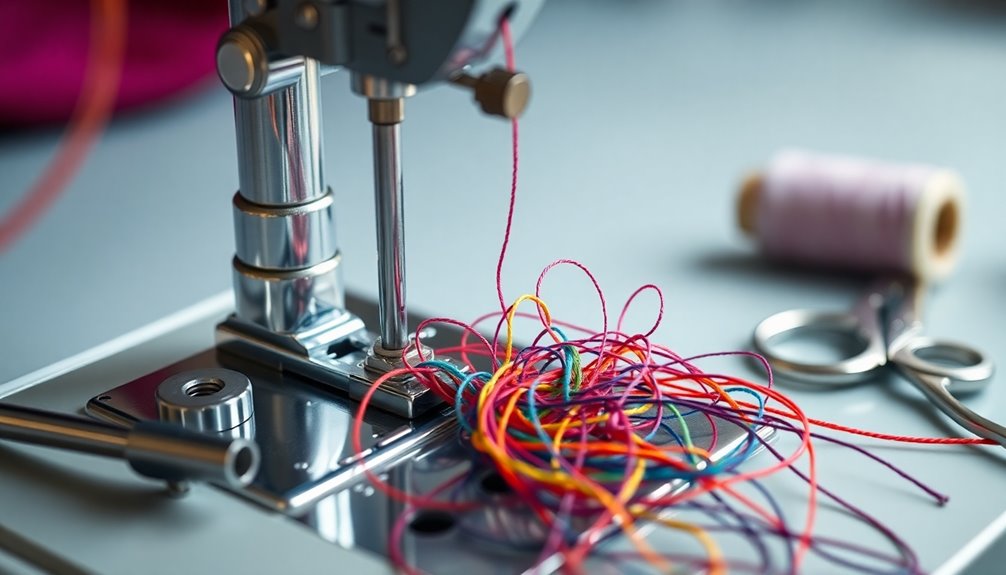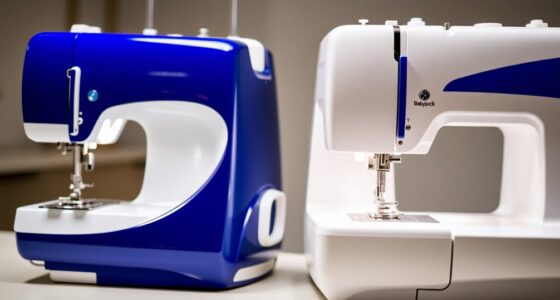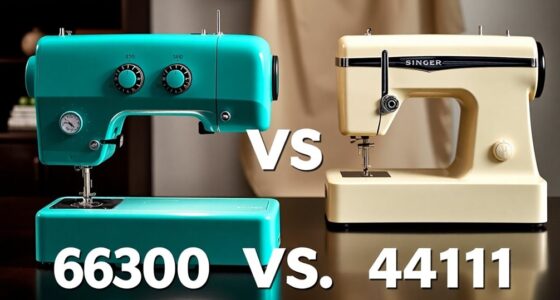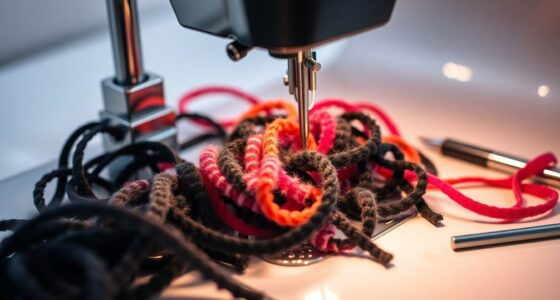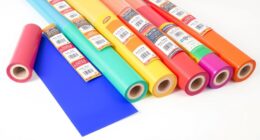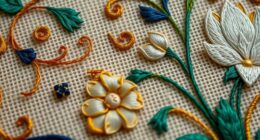If your sewing machine's jammed, don't stress! First, re-thread your machine and inspect the bobbin area for proper placement. Check your needle for damage and clean out any lint or debris. Adjust the thread tension to match your fabric, and make certain you're using high-quality thread. Regular maintenance can help prevent future jams. Want to know more tips to guarantee smooth sewing? You're in the right place for expert advice!
Key Takeaways
- Re-thread your machine carefully, ensuring the correct path and a raised presser foot to resolve tangling issues.
- Inspect and clean the bobbin area and feed dogs to eliminate lint and debris causing jams.
- Check the needle for damage or dullness; replace if necessary to prevent skipped stitches.
- Adjust the thread tension according to the fabric type to avoid jamming and inconsistent stitches.
- If problems persist, consult a professional to diagnose deeper mechanical issues and prevent further damage.
Common Causes of Sewing Machine Jamming
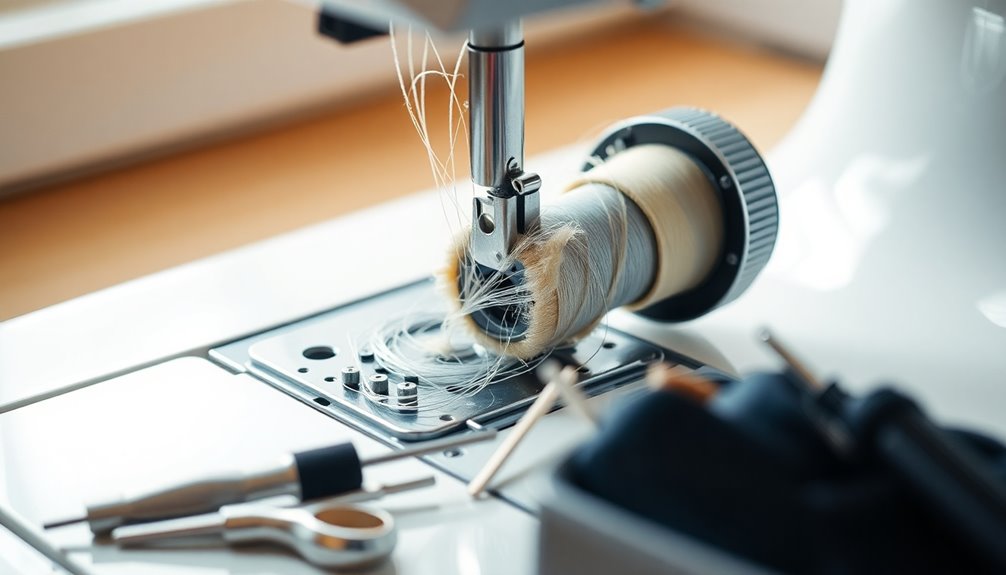
Sewing machine jams can be a frustrating issue, and understanding the common causes can help you prevent them.
One major culprit is improper threading; if you don't follow your machine's threading instructions, tangling can easily occur.
Another factor is incorrect tension—whether it's too tight or too loose, unbalanced thread can lead to jamming during operation.
Additionally, dull or damaged needles can snag the thread and fabric, resulting in frequent jams.
You should also keep an eye on lint and debris buildup in critical areas like the bobbin case and feed dogs, as this can impede movement and cause issues.
Finally, hitting pins or sewing over thick seams can cause the needle to get stuck, leading to more jams.
Symptoms of a Jammed Sewing Machine
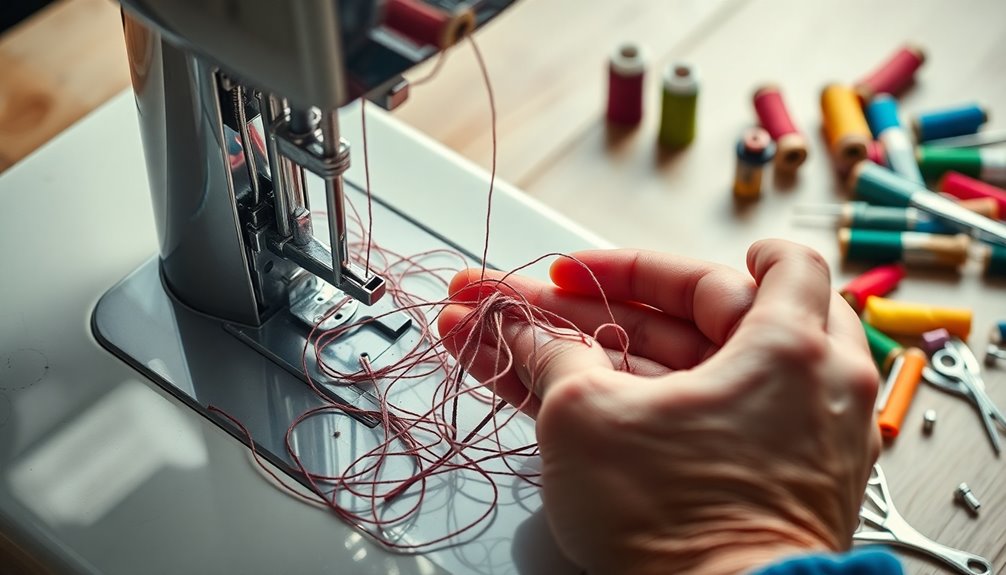
When your sewing machine jams, you might notice several symptoms that signal trouble. A jammed machine often shows the needle moving without the fabric advancing, hinting at feed dog or tension issues.
You may also see thread tangles that look like a bird's nest under the fabric, typically caused by incorrect threading or tension problems.
If you notice inconsistent stitch formation with gaps or skipping stitches, this could indicate a jam or a dull needle.
Additionally, listen for unusual sounds or grinding noises, which can signal internal jams or mechanical issues.
Finally, if the handwheel feels stiff or won't turn at all, that's a strong indication of a significant blockage within the machine's mechanism.
Step-by-Step Troubleshooting Guide
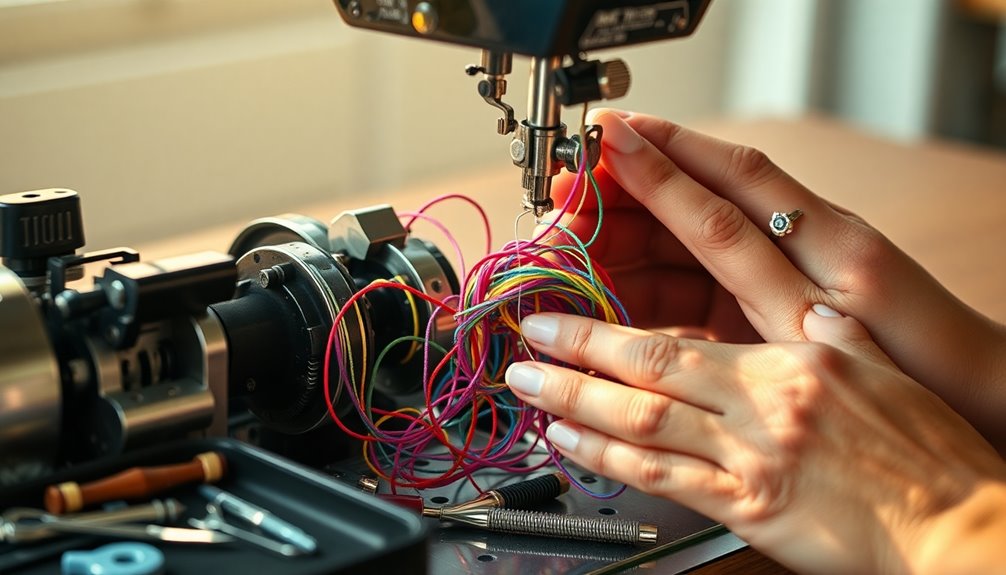
A jammed sewing machine can be frustrating, but following a systematic troubleshooting guide can help you resolve the issue efficiently.
Start by thoroughly re-threading your machine, making certain the thread follows the manufacturer's path and that the presser foot is raised.
Next, inspect the bobbin area for proper placement and winding; misalignment can lead to jams.
Don't forget to clean out any lint and debris around the feed dogs and bobbin area, as buildup obstructs movement.
Check your needle for damage or dullness, replacing it if necessary.
Finally, verify the thread tension is appropriate for your fabric type; improper tension can cause uneven stitches and increase the likelihood of jamming.
Checking and Adjusting Thread Tension
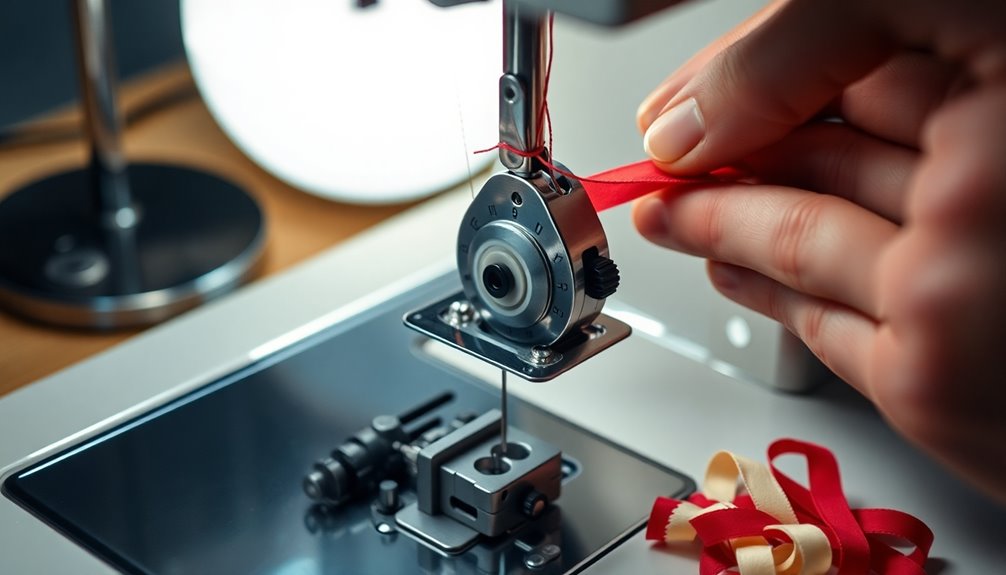
After troubleshooting the common causes of a jammed sewing machine, it's important to check and adjust the thread tension.
Proper thread tension is vital for achieving even stitches; too tight or too loose tension can lead to thread breaks or jams. Start by consulting your sewing machine's manual for the recommended settings based on your fabric type.
Always raise the presser foot when threading to guarantee the thread seats correctly in the tension discs. If you notice uneven stitches or jamming, test different tension settings on a scrap piece of fabric to find the ideal tension for your project.
Don't forget to regularly clean the tension discs of lint and debris to maintain consistent thread tension and prevent further issues.
Importance of Needle Condition

Needle condition plays an important role in your sewing machine's performance. A dull or damaged needle can lead to skipped stitches and increased thread breakage, causing frequent machine jams. To guarantee smooth sewing, always choose the correct needle type for your fabric. Regularly replacing your needle—ideally after every project—helps maintain ideal thread tension and prevents issues.
| Needle Type | Fabric Type | Result |
|---|---|---|
| Ballpoint Needle | Knits | Prevents snagging |
| Sharp Needle | Woven Fabrics | Smooth stitches |
| Correct Size | Lightweight Fabrics | Avoids fabric snags |
Using the right size needle is vital; an oversized needle can cause issues, leading to more frustrating jams. Keep your needle in check for better results!
Inspecting the Bobbin Area
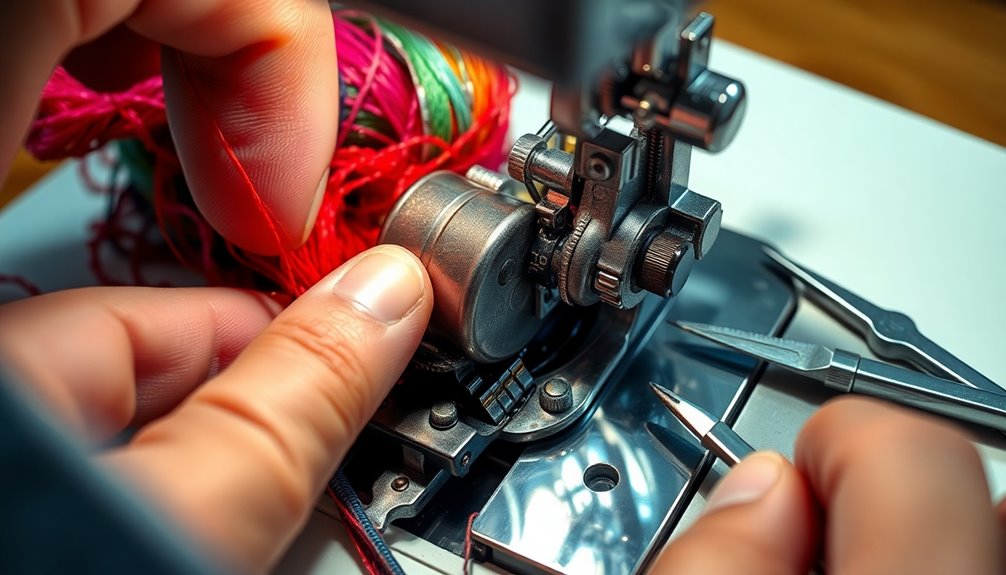
Inspecting the bobbin area is essential for keeping your sewing machine running smoothly.
Start by checking for any lint or thread buildup, as this can cause jams and affect stitching quality. Verify the bobbin is seated correctly in the bobbin case and wound evenly to avoid tangling.
A damaged or misaligned bobbin case can lead to thread catching, so look for any signs of wear or misalignment. Don't forget to remove the bobbin case periodically for cleaning; debris accumulation can impede performance.
Additionally, make sure the bobbin type matches your machine's requirements. Using incompatible bobbins can lead to jamming and malfunction, so always double-check compatibility before you start sewing.
Cleaning and Maintaining Your Machine
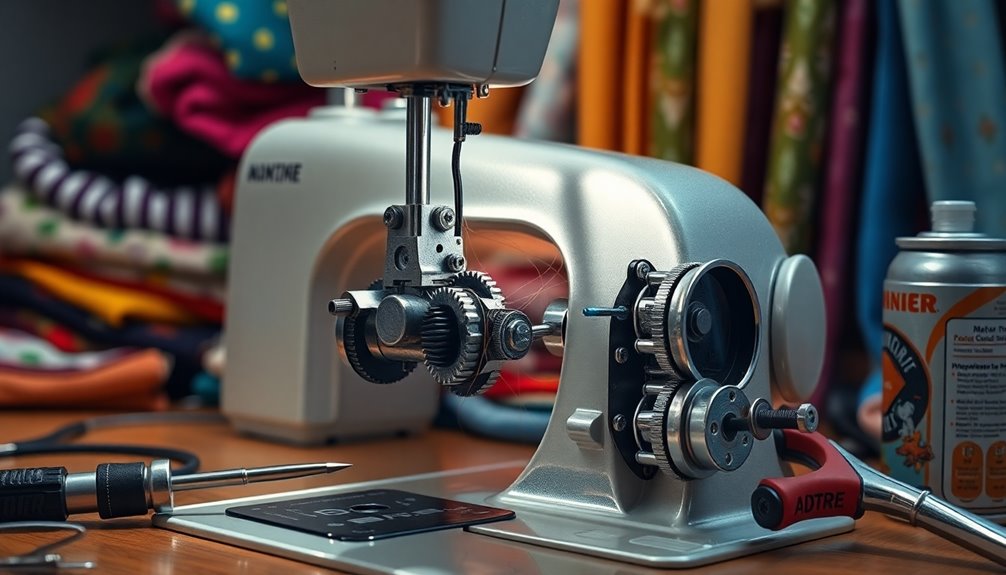
To keep your sewing machine running smoothly, create a regular cleaning schedule that includes the bobbin area and feed dogs.
Don't forget to lubricate the moving parts with the right oil to prevent binding and guarantee peak performance.
Regular Cleaning Schedule
While it might be tempting to skip cleaning your sewing machine after a long session, establishing a regular cleaning schedule is vital for its performance. Aim to clean your machine every 4-6 hours of use to prevent lint buildup that can lead to frustrating jams.
Use a small brush or tweezers to remove lint from the feed dogs and bobbin area, as even tiny debris can hinder your machine's efficiency. Don't forget to clean the tension disks periodically with a soft cloth to maintain ideal thread tension and stitch quality.
Finally, keep your sewing machine covered when not in use to minimize dust accumulation. Consistent maintenance and proper usage will keep your machine running smoothly and extend its lifespan.
Lubrication Best Practices
Regularly lubricating your sewing machine is essential for keeping it in top shape and preventing frustrating jams. Proper lubrication of moving parts reduces wear and tear, ensuring smooth operation.
Always use sewing machine oil recommended by the manufacturer; using the wrong oil can attract lint and cause problems. Apply oil sparingly to critical areas like the needle bar, presser foot lever, and hook assembly, wiping away any excess to avoid dust buildup.
Before lubricating, thoroughly clean your machine to remove lint and debris, especially from the bobbin case and feed dogs.
Schedule this maintenance every two to three months or after heavy use to extend the life of your sewing machine and maintain its ideal performance.
Upgrading Your Thread Quality
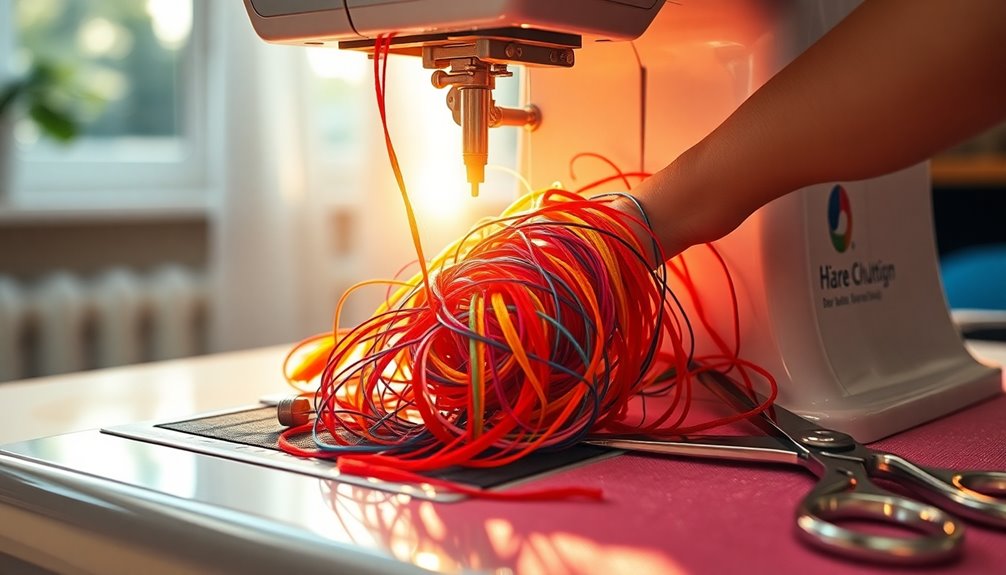
Upgrading your thread quality is essential for smoother stitching and fewer jams.
By choosing the right type and thickness for your fabric, you can enhance your machine's performance and reduce wear.
Plus, investing in reputable brands guarantees you get consistent quality, making your sewing projects more enjoyable and professional-looking.
Importance of Quality Thread
Investing in high-quality thread can greatly enhance your sewing experience, as it reduces the likelihood of fraying or breaking.
When you choose quality thread, you're less likely to encounter machine jams that interrupt your workflow. High-quality threads guarantee better stitch formation and consistency, making your projects look more polished.
Unlike low-quality alternatives, premium threads are made from stronger materials, minimizing knots and tangles that can disrupt your sewing. Additionally, they generate less lint, which means less maintenance for your machine and a longer lifespan. Furthermore, maintaining optimal performance through proper thread selection is essential for a smoother sewing process.
Upgrading your thread quality is a simple yet effective way to improve your overall sewing experience, allowing you to focus on creativity rather than frequent troubleshooting.
Thread Types for Fabrics
Choosing the right thread type for your fabric can make a significant difference in your sewing projects. For most fabrics, polyester thread is versatile, while cotton thread shines in quilting and natural fibers.
If you're using specialty threads like metallic or embroidery, be prepared to adjust tension and select the right needle size. High-quality threads, such as those from Gutermann or Aurifil, reduce fraying and breakage, decreasing the chance of jams.
Remember, thread weight matters too; opt for lighter threads (50 wt) for delicate fabrics and heavier ones (30 wt) for top-stitching.
Always consult your sewing machine manual to match the thread type with the appropriate needle size, ensuring smooth and efficient sewing.
Recognizing Thread Wear
High-quality thread can make all the difference in your sewing experience, especially when it comes to avoiding knots and jams.
Regularly check your thread for signs of wear, like fraying and uneven winding. Addressing these issues early can save you from frustrating sewing machine troubles.
Here are three signs that your thread might need replacing:
- Fraying – Threads that are starting to unravel can lead to breakage.
- Uneven Winding – This can cause tension problems, resulting in inconsistent stitching.
- Discoloration – If your thread looks faded, it might be deteriorating.
Using the right thread for your fabric type and ensuring it matches your needle size is vital.
Invest in quality to keep your projects smooth and enjoyable!
Tips for Preventing Future Jamming
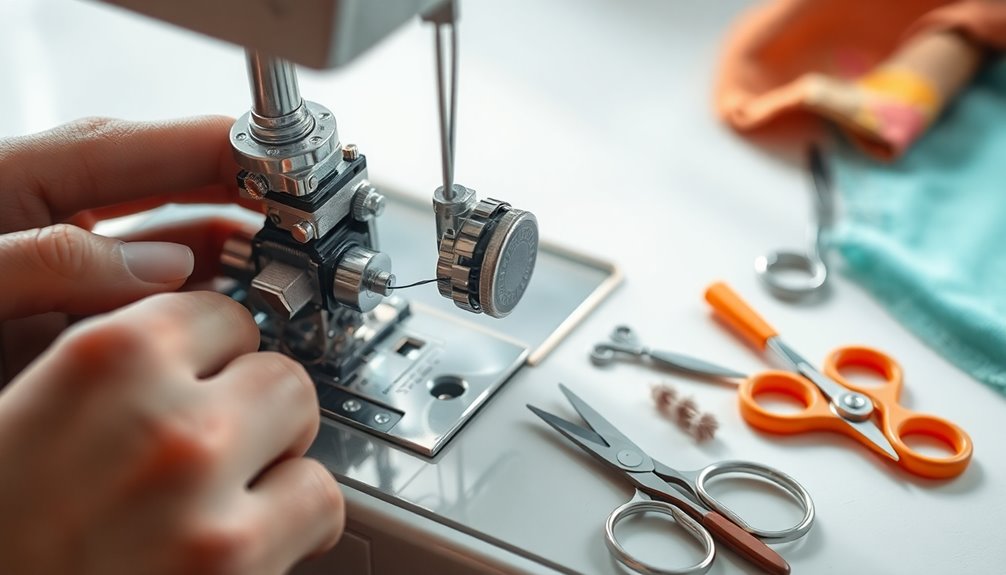
To keep your sewing machine running smoothly and prevent future jamming, make it a habit to regularly clean it. Focus on the feed dogs and bobbin area to avoid lint buildup. Here are some essential tips:
| Action | Frequency |
|---|---|
| Clean the machine | After each project |
| Check thread quality | Before each use |
| Re-thread your machine | If issues arise |
| Adjust tension settings | As needed |
Use high-quality thread compatible with your fabric. Always follow the manufacturer's instructions for threading or tension settings. Finally, schedule regular maintenance and proper servicing every two years to keep all moving parts lubricated and functioning well.
When to Consult a Professional

If your sewing machine keeps jamming despite your best efforts, it might be time to call in a professional.
Complex mechanical problems, like issues with the feed dogs or handwheel, often require expert diagnosis.
Don't wait too long; getting help quickly can save you from further damage and downtime.
Persistent Jamming Issues
While you might be able to fix minor jamming issues on your sewing machine, persistent problems can signal more serious mechanical concerns.
If your machine continues to jam despite thorough cleaning and re-threading, it's time for a professional inspection.
Consider seeking expert help if:
- You've replaced the needle and adjusted tension settings, but jamming persists.
- You hear unusual sounds or feel resistance when operating the handwheel.
- You've tried multiple troubleshooting steps without success.
Don't let these ongoing jamming issues frustrate you further.
Consulting a professional can save you time and guarantee your machine is restored to peak working condition, preventing potential damage and costly repairs down the line.
Complex Mechanical Problems
Persistent jamming can often hint at complex mechanical problems lurking beneath the surface of your sewing machine.
If you've cleaned and re-threaded your machine but it still jams, you might be facing deeper mechanical issues. Signs like unusual noises, persistent jams despite your best troubleshooting efforts, or consistent needle breaking indicate it's time for a professional assessment.
Attempting to fix these complex problems on your own can lead to costly repairs. A trained technician can address misalignment of internal components and timing issues, ensuring your machine runs smoothly.
Seeking expert help not only saves you time but also prevents further damage, allowing you to get back to sewing efficiently.
Frequently Asked Questions
How Do You Unlock a Jammed Sewing Machine?
To release a jammed sewing machine, first, turn off the power and carefully remove any fabric or thread caught around the needle and bobbin area.
Inspect the bobbin case and feed dogs for lint, cleaning them with a small brush.
If the handwheel's stuck, gently turn it to find any resistance.
Finally, re-thread the machine, ensuring the thread's seated correctly.
If it still jams, consult your manual or seek professional help.
How Do You Reset the Tension on a Sewing Machine?
To reset the tension on your sewing machine, start by raising the presser foot to open the tension discs.
Then, locate the tension dial and adjust it to the recommended setting, typically between 3 to 5 for most fabrics.
If your machine has a tension release lever, use it while re-threading.
Finally, test your stitches on a scrap piece of fabric, adjusting further if needed, and remember to clean the tension discs regularly.
How to Stop a Sewing Machine From Jamming?
If you think your sewing machine's jamming is just a part of the process, it's time to change that mindset.
To stop the jamming, start by re-threading your machine correctly, ensuring the presser foot is raised.
Clean the bobbin area and feed dogs regularly to eliminate lint.
Adjust the tension settings for your fabric type, and replace any damaged needles.
Routine maintenance will keep your machine running smoothly and prevent future jams.
What Is the Most Common Problem of the Sewing Machine?
The most common problem with sewing machines is thread jamming. It usually happens due to improper threading, tension issues, or lint buildup in the bobbin area.
You might also experience jams from a dull or bent needle, so make sure to check those regularly. Additionally, misalignment in the bobbin case can cause inconsistent stitching.
To avoid these issues, keep your machine clean and well-maintained, adjusting the tension based on the fabric you're using.
Conclusion
Don't let a jammed sewing machine ruin your creativity! By following the troubleshooting steps and maintaining your machine, you can keep it running smoothly, just like a well-tuned instrument. Remember to check your thread tension and needle condition regularly, and invest in quality thread. With these tips, you'll prevent future frustrations and enjoy a seamless sewing experience. If problems persist, don't hesitate to consult a professional for help. Happy sewing!
